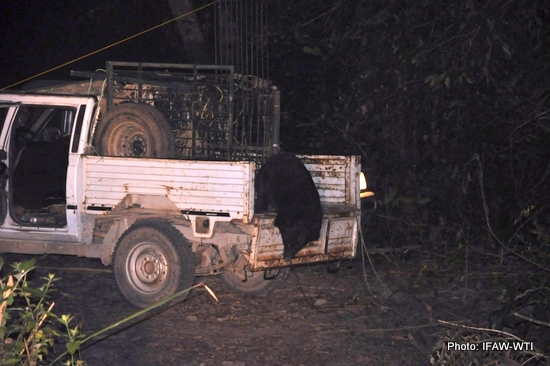
The bear walking out of the cage and heading towards Manas National Park
Kokrajhar, January 19, 2016: Increasing anthropogenic pressures on wildlife habitat often give rise to instances of wildlife entering human habitat, resulting in conflict situations that most often end unfortunately for the animal. Cases of Asiatic black bears entering human habitation have been few and far between. In 2009 and 2013 two bears in Chirang district of Bodoland Territorial Council (BTC) could not be saved despite the best efforts made by the Assam Forest Department and the IFAW-WTI team.
It was thus a thriller with a happy ending when an adult Asiatic black bear that had created panic for almost a week in Haltugaon Division near Manas National Park was rescued by the IFAW-WTI team stationed at Manas National Park and released back to the wild. The bear had injured four people and was seen in the area for almost a week before it was rescued and released following a thrilling sequence of events.
On January 10, Kampa Borgoyari, Deputy Chief of the Bodoland Territorial Council (BTC), alerted the BTC Forest Department officials and IFAW- WTI team on the presence of the bear. Soon after the information was shared, the IFAW- WTI Mobile Veterinary Service unit rushed to the spot and kept a vigil to ensure the safety of locals and the bear. Kampa Borgoyari also ensured complete support for rescuing the animal.
The MVS team — including Dr Brindavan Phangcho, the IFAW-WTI veterinarian — accompanied by forest officials, Forest Department veterinarian, local NGOs and youth kept up the vigil for a week but could not find an opportunity to tranquilise the bear. Finally, on January 17, the team was informed that the bear was sighted in the Alufarm area near Manas National Park. The team rushed to the spot and instructed Forest Department personnel and representative of local NGOs to put a net around the area where the bear was spotted. The area was covered with dense Eupatorium and rubber plantation that made it extremely difficult for the team to operate.
However, the team decided to go ahead with the operation and two tractors were moved in from opposite directions which forced the bear to run towards the net. However, the bear tore through the net and escaped. The team followed the bear and again put up nets where the animal was hiding. This time the bear was finally trapped and the team was able to tranquilise the animal. In order to avoid any confrontation with the mob of local residents, the bear was put in a cage and shifted to a safer place immediately. After detailed discussions with the BTC officials, the bear identified as female was released at Daimary Road in Manas National Park at 6 pm the same evening.
“The technique of using nets to cordon off the area and subsequently sedating the bear was employed for the first time in such a situation. Also, to see the bear being released into Manas National Park was a heartening experience,” said Dr Daoharu Baro, the IFAW-WTI veterinarian. It was the collaborative efforts of Dr Prabhat Basumatary, Forest Veterinary Officer, Manas NP; Dr Daoharu Baro; RN Boro, DFO Kokrajhar; Omio Bramha, Ranger; civil police authorities; and Haltugaon Forest Division staff that made this a successful rescue and release operation. Co-operation of local NGOs –Daokha Raja and Green Forest Conservation Force – also helped in ensuring that the bear could return back into the wild.
“Continued efforts by all stakeholders from January 10 to 17 paid off and the bear was successfully rescued and released on the same day in Manas National Park. On behalf of the Assam Forest Department, I would like to thank everyone for such a successful operation,” said RN Boro, DCF & DFO, WL Division, Kokrajhar.